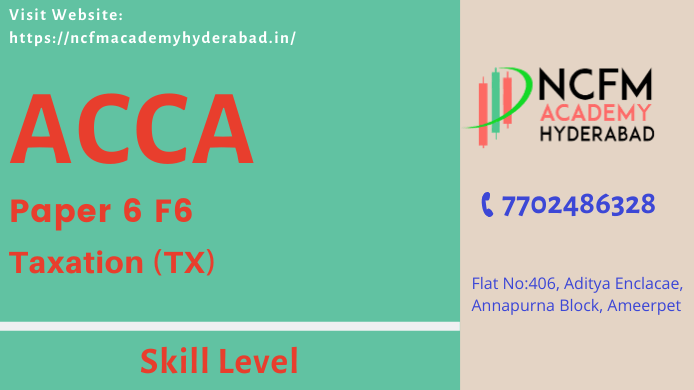Taxation (TX) is the sixth exam of your ACCA journey that you will be required to appear in and the third exam of the ACCA skills level. The course of Taxation (UK variant) is designed to give the students the basic understanding about the system of taxation and tax matters in the U.K. It provides the core understanding of the underlying principles and gives the students understanding of the major areas of taxation pertaining to taxation of individuals and businesses. NCFM Academy Hyderabad, one of the leading ACCA training centers in Hyderabad, offers ACCA Paper F6 Taxation in its Ameerpet center.
Exam Format
Taxation (TX) is a three-hour computer-based examination where all questions will be compulsory. All areas of the syllabus will be tested. The paper will be based on computational and discursive elements and some questions will have a scenario or case study like approach.
Section A comprises 15 objective test questions of 2 marks each
Section B comprises three questions each containing five objective test questions.
Section C comprises one 10 mark and two 15 mark constructed response questions. The two 15 mark questions will focus on income tax (syllabus area B) and corporation tax (syllabus area E).
Tax, rates, allowances, and other relevant information will be provided in the examination.
Syllabus of ACCA F6 Taxation
The syllabus is divided into six sections with further sub-sections.
A- The UK tax system and its administration
This is the first section of this syllabus and it will introduce the students to the concept, need and underlying principles of taxation in a society. Students will be introduced to direct tax, indirect tax, capital tax, and revenue tax.
An introduction of the taxation system of the UK will be given, students will learn about Her Majesty Revenue and Customs (HRMC) and its terms of reference. This section will introduce the concepts of tax evasion and tax avoidance and the purpose of the General Anti Abuse Rule (GAAR). The concept of double taxation agreements will be covered along with the need to adopt an ethical and professional approach in tax matters.
Students will be required to understand and explain the self-assessment system pertaining to individuals and companies. Students should know the dates for filing and submission of a tax return for individuals and companies, rules pertaining to corporation tax and the information and record taxpayers need to keep for taxation purposes.
This section also required the students to understand the situations when HMRC can make compliance checks on self-assessment returns and the procedures for dealing with appeals. Students will also be required to have technical proficiency in calculating late payment interest and state the penalties that can be charged.
B- Income tax and NIC liabilities

This is the second section of this course and it mainly covers the taxation of individuals. In this section students will learn the scope of taxation for individuals and how to determine the income for individuals, the criteria to distinguish between the salaried person and self-employed person. Understand and calculate the taxable income, allowable deductions, PAYE system and the benefits of the form P11D. Students will be required to recognize the situations where late filing may result in penalties and the extent of those penalties.
Students will be required to understand the criteria where a person is taxed as a self-employed person, recognize allowable expenditure and pre-tax relief, compute assessable profit based on the cash basis for small businesses, recognize and compute capital allowances and relief for trading losses.
This section will also cover the understanding and computation of assessable profits for a partnership and all the partners in a partnership and the loss relief claims available to partners.
This section also covers matters related to property and investment income. Students will also be required to understand and compute the national insurance contributions for employed and self-employed persons. Explanation and computation of relief given for contribution to personal and occupational pension schemes are also included in this section and students will be required to have technical proficiency. Students will be required to understand how a married couple or a couple in a civil partnership can reduce their tax liability.
C- Chargeable gains for individuals
This is the third section of this course and it covers the scope, understanding, and treatment of capital gains and losses. The gains and losses on the disposal of movable and immovable property and also gains and losses on the disposal of shares and securities.
D- Inheritance tax
The fourth section of this course deals with the inheritance tax, its computation, and exemptions. Students will be required to identify the persons chargeable and apply the meaning of transfer of value and exempt transfers. Students will be required to understand and compute the tax implications of lifetime transfers and relevant liabilities and also learn to compute the liability of the death estate.
E- Corporation tax liabilities
This is the fourth section of this course and it focuses on corporate taxation liabilities. This section covers the scope of corporation tax and students will learn about the tax year, date for filing and the resident status of a corporation. Students will learn how to compute the taxable profit and tax liability of a company and the exemptions and allowances which are available to a corporation.
F- Value added tax (VAT)
This is the sixth section of the course and it introduces the concept of Value Added Tax(VAT). Students will be required to learn and understand the requirements for VAT registration and deregistration and situations where input tax can be recovered. Students will be required to compute VAT payables and recoverable. This section also requires students to understand and identify situations when it will be advantageous to use VAT special schemes.
